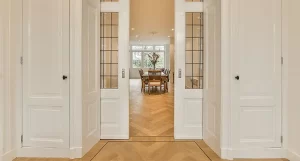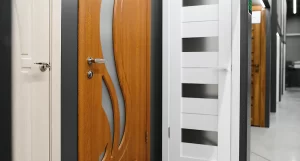In the ever-evolving world of construction, staying on top of design and functionality details is crucial. One of the standout elements that can elevate both the aesthetic and practicality of any project is the choice of doors—both interior and exterior door types.
For contractors, selecting the right doors is more than just a style choice; it directly affects how a space looks, feels, and performs, especially in terms of energy efficiency and security. Being informed about the modern door style options is essential for meeting clients’ needs, complying with building codes, and staying competitive in the industry.
In this blog, we’ll dive into various types of doors every contractor should be familiar with, from classic flush doors to elegant french doors and sturdy steel doors. We’ll explore their unique features, benefits, and ideal applications, equipping you with the knowledge to make informed decisions that suit your clients’ requirements.
Whether you’re renovating a home or designing a commercial space, understanding these door options can lead to impressive results and keep your projects fresh and modern. Let’s discover how the right doors can significantly enhance your construction projects!
Types of Interior Doors
Flush Doors

Flush doors are a popular choice for indoor spaces thanks to their simple, clean design. They come in two types: solid core, which is stronger, and hollow core, which is lighter and easier to handle. With their flat surfaces and no frills, flush doors fit perfectly into modern aesthetics. Plus, you can paint them, use laminate, or apply veneer to match any interior style.
One of the standout features of flush doors is their durability. Solid core interior doors are particularly robust and do a great job of blocking sound, while hollow core doors are great for those looking for something lighter. They also come in standard sizes, making them practical for builders who appreciate consistency in their projects.
Another plus is the customization options available. You can choose different finishes and hardware, giving you the flexibility to complement various themes in homes or businesses.
Panel Doors

Panel doors are a timeless choice for indoor spaces, featuring a distinctive design with one or more panels set within a frame. They can be simple or ornate, making them a great fit for various architectural styles. The panels can be raised, recessed, or flat, offering plenty of options to customize them to suit your decor.
Typically made from solid wood, engineered wood, or composite materials, panel doors are both strong and durable. Their solid construction helps with insulation and soundproofing, making them ideal for areas where privacy matters.
You’ll find panel doors in a wide range of styles and finishes, from paint and stain to natural wood, adding character and warmth to spaces like hallways, bedrooms, and offices. They can be single panel door, 2, 3, 4 or 5 panel door and even a six panel door. Their classic look combined with their sturdy nature makes them a favorite for contractors who appreciate both aesthetics and functionality in various settings.
French Doors

French doors are a stylish and versatile choice for indoor spaces. Typically featuring two symmetrical panels with glass inserts, they allow plenty of natural light to flow between rooms, creating a lovely visual connection. They’re perfect for areas where you want to keep things open, like between living spaces or from a hallway to a home office.
Usually made from wood or fiberglass, French doors in interior space can be customized in a variety of finishes and styles, ranging from traditional to modern. The glass panels can be clear, frosted, or patterned, giving you options for privacy while still letting light in. One of the biggest advantages of steel French doors is that they can make smaller rooms feel larger and more inviting. They separate spaces without fully closing them off, helping to maintain an airy atmosphere—especially in open-concept designs.
Installing a double French door can be a bit more challenging than standard doors, as they require proper alignment and can be heavier, especially if they’re double doors. However, when installed correctly, they become a stunning focal point in any room, enhancing the overall aesthetic.
Glass Doors

Glass doors are a sleek and modern option for indoor spaces, allowing light to flow beautifully between rooms while enhancing visibility. Typically framed in materials like wood, aluminum, or steel, they can feature various types of glass doors—clear, frosted glass door, tinted, or patterned glass doors—offering a balance of privacy and brightness.
One of the standout benefits of glass doors is how they create an open, airy feel, making them ideal for contemporary and minimalist interiors. They’re perfect for separating living areas, home offices, or even serving as stylish closet doors, combining functionality with aesthetic appeal. You’ll find glass doors in different designs, including sliding, hinged, or bi-fold. Sliding doors are great for saving space, while hinged doors offer a more traditional look. Durability is key, and tempered glass is often used for its safety and strength, making these doors suitable for high-traffic areas. Plus, they’re easy to maintain—just a bit of regular cleaning keeps the glass crystal clear.
For contractors, glass doors are a versatile choice that can elevate a project’s design, merging functionality with a modern vibe that many homeowners and businesses love.
Pocket Doors

Pocket doors are a smart and space-saving solution for indoor doorways. Instead of swinging open like traditional doors, they slide neatly into the wall, disappearing completely when opened. This feature makes them ideal for tight hallways, small rooms, or areas where furniture might otherwise get in the way.
You can find variety of pocket doors such as wood pocket doors, MDF, or glass pocket doors, and they can be customized to match your home’s style. With options for painted surfaces, natural wood finishes, and either solid or glass panels, you can choose the level of privacy and light that works best for your space.
Installing double pocket doors can be a bit more complex than standard doors because they require a special wall space, or “pocket,” to slide into. This means careful planning and precise measurements during installation, so attention to detail is crucial for contractors.
One of the biggest benefits of pocket doors is that they create an open passage when not in use, allowing for smooth movement between rooms. They’re particularly useful in smaller spaces since they don’t require the extra room that swinging doors do.
Double Doors

Double doors are a stunning choice for indoor spaces. Featuring two doors that open from the center, they create a wide entrance that not only makes moving in and out easier but also adds a touch of elegance to areas like dining rooms, entryways, or offices.
Typically made from wood or a combination of materials, Interior double doors can be customized in various styles and finishes to match your decor. You can opt for solid panels for a classic look or incorporate glass elements to let in more light, making the space feel brighter and more open.
One of the great things about a double door is that it creates an inviting atmosphere, making rooms feel larger and more welcoming. They’re perfect for connecting different areas of a home or office, allowing for a smooth flow while adding visual interest.
Installing double doors does require some careful planning to ensure the door frame and hinges are properly aligned. This may involve a bit more framing work than single doors, so it’s something for contractors to keep in mind during the project.
Double doors blend functionality with style, making them a popular choice for contractors looking to enhance the appearance and accessibility of interior spaces. They can fit seamlessly into a variety of design styles, from traditional to modern.
Bi-Fold Doors

Bi-fold doors are a practical and stylish choice for indoor spaces. They fold in on themselves when opened, making them perfect for areas where traditional doors might be a hassle, like laundry rooms, closets, or even as room dividers.
Usually made from materials like wood, composite, or glass, bi-fold doors can be customized to fit a variety of interior designs. You have options for different finishes and styles, including solid panels or glass inserts that let in light while still providing some separation between spaces.
One of the biggest advantages of bi-fold doors is their ability to open up an entire wall, creating a seamless transition between rooms or even connecting indoor spaces to outdoor areas. This feature is especially beneficial in open-concept layouts, where maximizing space and flow is essential.
Installing a bi-fold door does require careful alignment and proper framing to support the folding mechanism. This can involve a bit more complex carpentry than standard doors, so contractors need to plan thoroughly during installation.
Accordion Doors

Accordion doors are a fantastic space-saving solution for indoor areas. They fold up in a concertina style when opened, making them ideal for tight spots like closets, pantries, or as room dividers in larger spaces.
Typically made from lightweight materials like vinyl, laminate, or wood, accordion doors come in various styles and finishes to complement your decor. Many feature clear or frosted panels that allow light to flow while still offering some privacy.
One of the biggest advantages of accordion doors is their flexibility. You can open them up to create a larger area or close them off when you need privacy. This versatility makes them perfect for offices, studios, or homes that benefit from adaptable layouts.
Installing accordion doors is generally straightforward, but it does require careful measuring and alignment to ensure they open and close smoothly. Contractors also need to think about how much space is needed for the door to fold back and plan the track system accordingly.
Accordion doors are a practical choice for maximizing space while adding a stylish touch to your interior design. Their lightweight construction and customizable styles make them appealing for both residential and commercial projects.
Bypass Doors

Bypass doors are a practical and efficient choice for indoor spaces. They slide past each other on a track system, making them ideal for tight areas where a traditional swinging door would be too cumbersome. This feature makes them perfect for closets, storage spaces, or even as room dividers.
Typically made from materials like wood, MDF, or glass, bypass doors can be customized in various styles and finishes to suit different interior designs. You can opt for solid panels for privacy or glass inserts to let in light, offering a nice balance. One of the main benefits of bypass doors is their space-saving design; they don’t require extra room to swing open. This makes them especially popular in smaller rooms or multifunctional spaces where flexibility is key.
Installing bypass doors involves careful measuring and aligning the track to ensure they slide smoothly. Contractors also need to account for the weight of the doors to ensure the track system is strong enough to support them.
Bypass doors offer a stylish and space-efficient solution for contractors looking to enhance functionality in various interior settings. Their versatility and ease of use make them a great option for both homes and businesses.
Types of Exterior Doors
Steel Doors

Steel doors are a popular choice for front entrances, and it’s easy to see why. Builders love them for their durability and security. Made from thick steel, these exterior steel doors can handle impacts and tough weather, making them ideal for busy areas or places with harsh conditions. Plus, they often include insulation materials like polystyrene or polyurethane, which help keep homes energy-efficient.
When it comes to security, doors of steel shine. They typically feature reinforced frames and high-quality locks, making it difficult for intruders to break in. Aesthetically, they’re versatile too—available in various colors and textures to match different architectural styles. And the best part? They require minimal upkeep; with the right care, they resist warping, cracking, and rust.
Installation is straightforward, as steel doors can be customized to fit a range of sizes for both homes and businesses. While they are heavier and need careful handling during installation, they generally outlast doors made of wood or fiberglass.
Aluminum Doors

Aluminum doors are becoming a go-to choice for builders when it comes to outdoor entrances, and it’s easy to see why. They’re lightweight yet strong, made from high-quality aluminum that won’t rust or deteriorate easily—perfect for areas that experience extreme weather or moisture. Plus, their sleek, modern design can really enhance the look of any building, fitting in nicely with a variety of architectural styles.
One of the standout features of aluminum doors is their energy efficiency. Many come with special designs that minimize heat transfer, helping to keep homes warm in winter and cool in summer, which can really help lower energy bills. Some models even have double or triple layers of glass for added insulation and noise reduction.
In terms of security, aluminum doors can be fitted with strong locks, making them a safe choice for both homes and businesses. They’re also customizable, available in various colors and finishes to match any design project.
Installation is a breeze since aluminum doors are so lightweight. They often come ready to install, making the whole process straightforward. Plus, they require minimal maintenance—just the occasional cleaning keeps them looking great. Overall, aluminum doors offer builders a versatile and efficient option for reliable exterior entrances.
Fiberglass Doors

Fiberglass doors have become a popular choice for outdoor entrances, and for good reason. They’re durable, energy-efficient, and easy to maintain. Crafted from high-quality fiberglass, these doors can stand up to tough weather without warping, cracking, or fading, making them suitable for all climates—whether it’s scorching hot, freezing cold, or humid.
One of the standout features of fiberglass exterior doors is their excellent insulation. Many come with an energy-efficient core that helps keep indoor temperatures stable, which can lead to lower heating and cooling bills. Plus, they can be designed to mimic the look of wood, giving you a stylish option without the typical issues that come with real wood.
Security is another strong point, as fiberglass doors can be fitted with robust locks and reinforced frames. They’re available in a variety of styles and finishes, allowing them to blend seamlessly with any building, whether it’s a home or a business.
When it comes to installation, a fiberglass door is usually lightweight and easy to handle. Many Fiberglass doors come pre-hung, which speeds up the installation process. Maintenance is a breeze, too—just a bit of regular cleaning is all they need, and you won’t have to worry about painting or staining like you do with wood doors.
PVC Doors

PVC doors, made from polyvinyl chloride, are becoming a popular choice for outdoor entrances, and it’s easy to see why. They’re lightweight, durable, and weather-resistant, making them ideal for all kinds of climates. Since they don’t absorb moisture, they’re especially great for humid or coastal areas where wooden doors might warp or rot. Their smooth, non-porous surface also helps prevent mold and mildew, which means they can last longer.
One of the standout features of PVC doors is their energy efficiency. Many have insulation that helps keep indoor temperatures stable, which can help lower energy bills. Plus, they come in a variety of styles and colors, allowing you to customize them to fit different building designs while adding a modern touch.
In terms of security, while PVC doors might not be as strong as metal options, they can still be fitted with reliable locking systems for peace of mind. Their lightweight design makes installation a breeze, as they’re easy to handle and often come pre-hung.
Also Read: Architects and Builders’ Guide to Choosing the Right Door Supplier
Key Takeaways

In the competitive world of construction, the little details matter—especially when it comes to choosing doors. Different styles, like sleek front doors with glass and traditional panel doors, each bring their own set of benefits that can really enhance both the functionality and the look of a space. By understanding the various options available, you can tailor your projects to meet your client’s specific needs, leading to happier customers and top-notch craftsmanship.
Remember, the right doors can significantly boost a property’s appearance, energy efficiency, security, and overall value. It’s also crucial to partner with a reliable door supplier like AORBIS. AORBIS offers high-quality doors and excellent support, ensuring you have access to the latest options, customization choices, and quick deliveries. This kind of partnership can help keep your projects running smoothly and efficiently.


























![ADA Requirements for Bathrooms [Informative Infographic]](https://www.aorbis.com/wp-content/uploads/2025/01/ADA-Requirements-for-Bathrooms.jpg)



